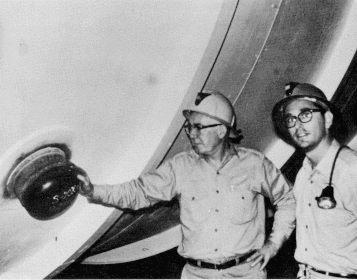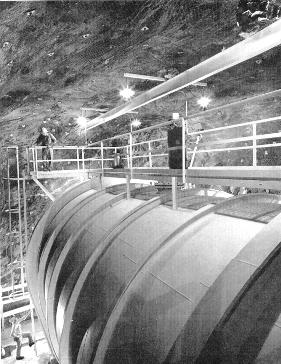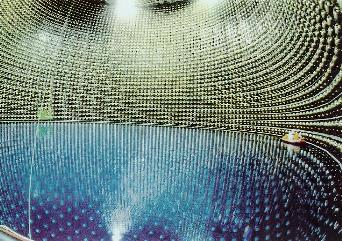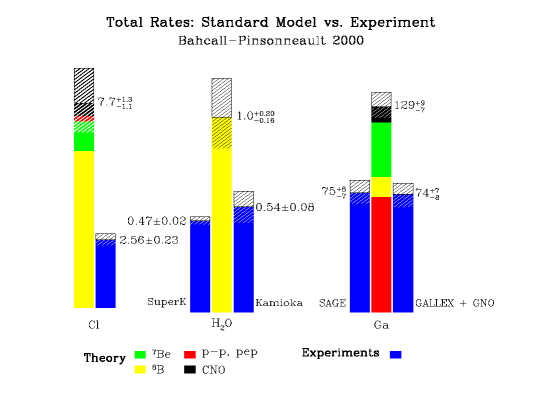The solar neutrino problem
In general scientists make progress by comparing what they see, either
directly in nature or in an experiment they perform,
from what they currently understand about the laws of nature.
Very often, scientists combine the many bits of information about what
they currently understand into a "model". For example, scientists
have for many years been constructing a model of the Sun. No, they don't
use balsa wood and glue to make this - the "model" in this case is
actually a description of the inside of the Sun. The model is a list of
things such as the chemical composition, temperature, pressure and
density of matter inside the Sun at different places ranging from the
core of the Sun all the way out to the visible surface.
An agreement between the experiment (or observation) and the model,
tells scientists they are
on the right track. In other words, the assumptions
that went into the construction of the model
are correct.
But, sometimes there is a disagreement. This is when things can get
really interesting, because it may mean that there is something going
on in nature which lies outside of our current understanding.
For many years there has been such a disagreement with the standard solar
model and observations of what are called neutrinos.
This famous discrepency is called the solar neutrino problem.
Although many scientists have participated, the principal problem
may in many ways be described as a thirty year disagreement between
the observations and the models made by
these two men:

A neutrino is a particle (not to be confused with the neutron)
which is believed to have no mass and travels at the speed of light.
Neutrinos are produced in the
cores of stars like the Sun
as a by product of
nuclear fusion.
They interact only weakly with matter, and speed out of
the core of the star essentially unimpeded.
This is important for scientists, because it means neutrinos coming
out of the Sun come directly from the core and can give us direct
information about the nuclear fusion going on there.
Observing neutrinos, either from the Sun or from anywhere else in
the universe, is difficult because most neutrinos aren't stopped by
most matter.
Scientists detect them
by collecting large amounts of certain kinds of matter which
are somewhat better at stopping the neutrinos, allowing them to
be counted. One of the substances used is a certain type of
chlorine, present in cleaning fluids.
In the first experiment
started more than 30 years ago, scientists placed a huge tank
of cleaning fluid deep underground in a gold mine in South
Dekota. (The tank was placed here to shield it from other types
of particles from space called cosmic rays).

At first, the scientists didn't detect any neutrinos at all in the
tank. Then, slowly at first, they began to see them. On average they
saw about one per day! However, it soon became clear that were just
not seeing as many as they thought they would, based on what they
understood from the amount of nuclear fusion going on in the standard
solar model.
To test that the observations were correct, scientists built larger
and more elaborate experiments. The most sensitive experiment built
to date is the "Super-Kamiokande" detector in Japan. This consists
of 50,000 tons of pure water filled in an underground tank
surrounded by 11,000 special tubes (called photomultiplier tubes).
(note the men in the small raft to the right of the photo - when
the experiment is running the entire tank is filled with water)
The tubes can detect the extremely faint light that is emitted when
neutrinos interact with the water. (Photo courtesy the
Institute for Cosmic Ray Research, University of Tokyo).

By now these and other independent experiments have confirmed what was
already indicated by the first experiment: the Sun is producing
approximately a factor of 2 fewer neutrinos than we expect that it should
be.

Over the years scientists have considered two possible explanations of the
solar neutrino problem:
1. Perhaps we don't understand the Sun well enough. Maybe a better theory
of the internal structure of the Sun would predict fewer neutrinos, in
agreement with the measurements.
2. Perhaps we don't understand neutrinos well enough; maybe they have some
features beyond the standard theory of neutrinos that account for the
problem.
At present it is difficult to accept (1) because the standard solar model is
very successful at describing many other aspects of the Sun (for example,
the results from
helioseismology). Thus much
recent attention has been focussed on the possibility that neutrinos do
something unusual. Most speculation centers on some varation of a theory
that there are three kinds (called "flavors") of neutrinos, and that their
passage through matter (like the Sun!) can cause one neutrino
flavor to "oscillate" into another.
It can be shown that if this is arranged in just the right way it could
account for the observed deficit of solar neutrinos, because
the detectors only measure one flavor of neutrino.
Evidence for the oscillation of neutrinos has in fact
been accumulating. However, the existence of these neutrino oscillations
contradicts another standard model in physics, called the standard
electroweak model.
Therefore, until scientist have something satisfactory
to replace this model, the "solar neutrino problem" will no doubt
remain with us as one of the more fascinating mysteries of the Sun!



